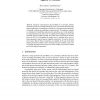Free Online Productivity Tools
i2Speak
i2Symbol
i2OCR
iTex2Img
iWeb2Print
iWeb2Shot
i2Type
iPdf2Split
iPdf2Merge
i2Bopomofo
i2Arabic
i2Style
i2Image
i2PDF
iLatex2Rtf
Sci2ools
ESOP
2005
Springer
2005
Springer
Analysis of an Electronic Voting Protocol in the Applied Pi Calculus
Electronic voting promises the possibility of a convenient, efficient and secure facility for recording and tallying votes in an election. Recently highlighted inadequacies of implemented systems have demonstrated the importance of formally verifying the underlying voting protocols. The applied pi calculus is a formalism for modelling such protocols, and allows us to verify properties by using automatic tools, and to rely on manual proof techniques for cases that automatic tools are unable to handle. We model a known protocol for elections known as FOO 92 in the applied pi calculus, and we formalise three of its expected properties, namely fairness, eligibility, and privacy. We use the ProVerif tool to prove that the first two properties are satisfied. In the case of the third property, ProVerif is unable to prove it directly, because its ability to prove observational equivalence between processes is not complete. We provide a manual proof of the required equivalence.
| Added | 27 Jun 2010 |
| Updated | 27 Jun 2010 |
| Type | Conference |
| Year | 2005 |
| Where | ESOP |
| Authors | Steve Kremer, Mark Ryan |
Comments (0)

